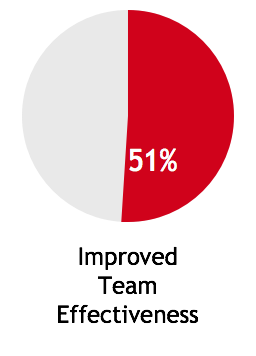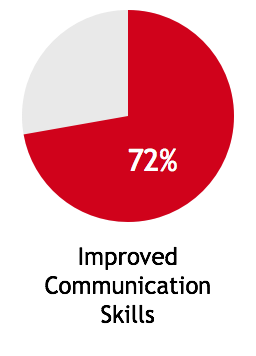Executive coaching brings many benefits: fresh perspectives on personal challenges, enhanced decision-making skills, greater interpersonal effectiveness, and increased confidence. And, the list does not end there. Those who undertake coaching also can expect appreciable improvement in productivity, satisfaction with life and work, and the attainment of relevant goals.
Increased Productivity
Executive coaching maximizes potential and, therefore, unlocks latent sources of productivity.
Positive People
Building the self-confidence of employees to face challenges is critical in meeting organizational demands.
Return on Investment
Coaching generates learning and clarity for forward action with a commitment to measurable outcomes. The vast majority of companies (86%) say they at least made their investment back.
Satisfied Clients
Virtually all companies and individuals who hire a coach are satisfied.
What was stigma “You’re so broken you need a coach?” has become status symbol, “You’re so valuable you get a coach!”. Tiger Woods and Michael Phelps have coaches. Microsoft ‘s young high-potential leaders get coaches. If elite athletes and organizations think they need coaches, shouldn’t you have one too? Shouldn’t we all?
Based on the latest research, here are four diagnostic questions you should ask before making the decision to hire a coach.
1. How valuable is this person’s performance and potential to your organization?
When done right, executive coaching is expensive and time-consuming. It should be reserved for people who are critical to your organization’s success, or will be in the future. In general, this includes everyone at C-level, heads of major business units or functions, technical or functional wizards, and your bench of high-potential young leaders.
Consider that a coach must have the experience and expertise to quickly grasp a leader’s situation, challenge assumptions and choices, and bring credible, fresh ideas to the table. Doing this with your best and brightest is not easy. And given the influence a coach can have on an executive’s decisions and actions over the course of a typical 12-to-24-month engagement involving monthly meetings, regular phone calls and e-mail check-ins, a bargain coach whose sophistication does not match the client’s is a big mistake.
2. What is the challenge the person is facing right now?
People, relationships, organizations and behavioral change are what executive coaches know best. When an executive is struggling to learn how to best manage herself and engage others, you’ve found the sweet spot for executive coaching.
He might be a chief executive officer trying to figure out how to work with his board chair. Or a regional vice president scaling up to global responsibility, learning how to lead her former peers. Or a technical wizard who destroys teams with his resistance to all ideas but his own.
But be warned: An executive coach is not a consultant. He may have technical or functional expertise. But he should not be used as an answer person, an extra pair of hands or a bolster for a weak leader. He helps executives think through and tackle their own problems. Self-reliance, not dependency, is the goal.
3. How willing and able will the executive be to work with a coach?
The client has got to want to change. A bright, motivated coaching client can step up to most challenges. A bright, unmotivated one will waste everyone’s time and money. Working with an executive who has been pressured into coaching by his boss or human resources department is an uphill battle, though it’s not impossible.
Coachability is important. Look for a track record of unusual growth under the guidance of teachers and mentors. Coachable executives readily share their experience. They are realistic about their strengths and weaknesses. They learn from others but do it their own way, taking responsibility for whatever happens. They know how to leverage a coach.
4. Are key people in the organization ready to support this person’s efforts to grow and change?
Changing the way you think and act is tough even when you have support from others. But when key leaders above or beside you are indifferent, skeptical or hostile to changes you’re trying to make, things get exponentially more difficult. Coaching works best when key people in the executive’s world stand solidly behind her. They need to provide tailwinds, not headwinds. Coaching relationships in a vacuum of support fall apart before any goals are achieved.
When conditions are right, executive coaching can be one of the best people investments you’ll ever make. But it is not a panacea for every executive development problem. Answer these four questions, and you’ll make better decisions about who is likely to benefit from coaching. And who isn’t.












